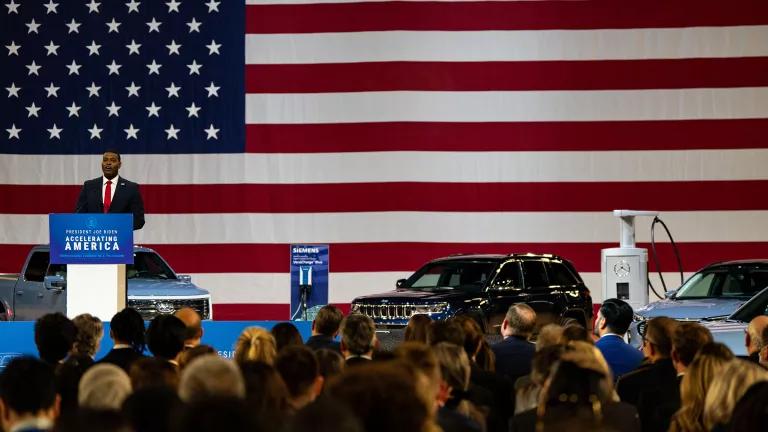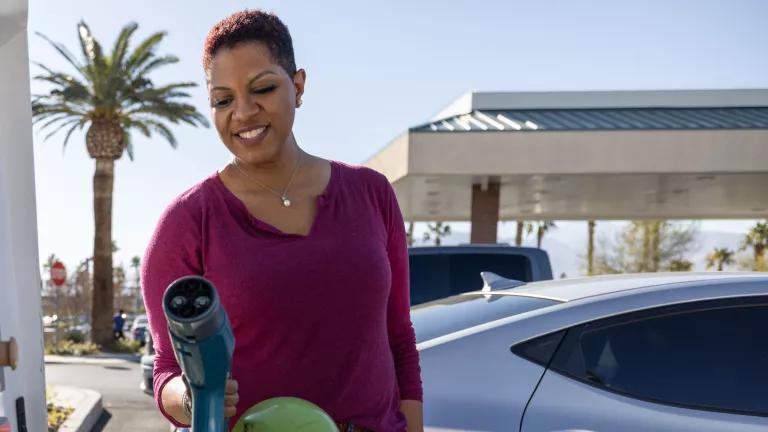
California and nine other U.S. states have joined forces to adopt a Zero-Emission Vehicles (ZEV) standard, helping to create one of the world’s largest markets for battery electric, fuel cell, and plug-in hybrid vehicles. But an NRDC-commissioned ZEV report released today shows the program needs a ‘tune-up’ to ensure the market expands well beyond current sale levels.
In fact, as I testified today before the Air Resources Board (CARB) that administers California’s program, without a ‘tune-up’ of the program, just one successful electric vehicle startup—Tesla Motors—could produce enough zero-emission vehicles to meet the entire auto industry’s requirements through 2025 with some moderate sales growth. That’s because a multitude of “extra credit” provisions are diluting the number of vehicles the auto industry will be required to deliver by more than a third.
Given that widespread deployment of clean electric cars and trucks is necessary to achieve significant reductions in global warming pollution, improve air quality, and cut our need for petroleum, it’s imperative the ZEV standard be tuned-up so that it can help meet those goals.
The background
The Zero Emission Vehicle (ZEV) standard, originally adopted in California in 1990 and now in force in nine other Clean Car ZEV states, has been a catalyst for investment and innovation by automakers. Multiple automakers have brought new models to the market, new entrants are competing for market share, and continued improvements in vehicle performance are all happening. Early deployment of the technology has helped lead to a 65 percent reduction in the costs of lithium-ion batteries that power electric vehicles in the past five years alone.
In 2013, the governors of eight of the ZEV states (California, Connecticut, Maryland, Massachusetts, New York, Oregon, Rhode Island, and Vermont), established a joint target of placing at least 3.3 million zero-emission vehicles on the road by 2025, meaning that over 15 percent of passenger car and light truck sales would be full battery electric, fuel cell, or plug-in hybrid. Maine and New Jersey are part of the ZEV program as well, but did not sign the Memorandum of Understanding.
Why the standard needs a tune-up
Our NRDC-commissioned study—by Shulock Consulting—looked “under the hood” of the ZEV standard to more thoroughly account for factors that can affect the volume and types of vehicles that will be delivered. These include “extra-credits” automakers can receive that effectively lower their required sales level, including more credits for longer-range vehicles, historic extra credits that had been “banked,” allowing the same vehicle to earn credits in multiple states under the so-called “travel” provision, and credits generated by new entrants like Tesla. The results show that, absent a tune-up of the credit structure of the program:
- The number of vehicles resulting will fall well short of the program’s goals and those established by the ZEV state governors. Automakers will only need 6 percent of their new vehicle sales annually to be electric-drive under the standard by 2025, versus the original 15.4 percent goal. Some automakers already met or exceeded a 6 percent sales level in California as early as last year.
- In California, only 1 million electric vehicles must be sold through 2025 to meet the ZEV standard, well short of the more than 1.6 million expected. Across the eight ZEV states that established the joint target of 3.3 million, only 2.1 million electric vehicles need to be sold by 2025, more than one-third less than intended.
- Even moderate growth for Tesla Motors could result in that one single company meeting the entire auto industry’s ZEV obligations. Under this scenario, the standard would become “non-binding” for other manufacturers who could simply comply through purchasing credits.

Creating an on-ramp for success
As I told ARB, which sets the rules for the standard that automakers in California and other ZEV states play by, any future program modification should be measured against the following goals:
- Increased certainty: Program updates should better ensure that ZEV goals will be met to deliver 1.5 million vehicles in California by 2025 and 3.3 million total across all ZEV states, retaining as many true ZEV vehicles as originally targeted.
- Trajectory for long-term: Consistent with California’s climate and air quality goals, establish a glide-path to reach at least 15 percent sales by 2025 and 33 to 40 percent sales by 2030.
- Improved product offerings: Including longer-range zero-emission vehicles and higher-performing plug-in hybrids across more diverse platforms (e.g. SUVs and light trucks).
- Achieve scale and success beyond California: Create a meaningful sales ramp for ZEVs in other ZEV states, ensuring sufficient product launches and marketing efforts are occurring in those markets as well.
An effective ZEV program ramp will result in automakers offering high-performing, electric-drive vehicles to consumers across all ZEV states, will help lead to diversified product portfolios including offerings in other vehicle size segments, and will activate greater marketing and outreach efforts. At the same time, state and federal programs can complement ZEV program targets through monetary incentive programs (e.g. tax rebates, utility EV rates); non-monetary rewards (e.g. carpool access); and consumer education programs. Many ZEV states have programs in place in each of the categories. However, a significant enough sales floor established by the ZEV program is necessary to help ensure market certainty and ultimate success.
What can be tuned up?
NRDC asked Shulock Consulting to evaluate different mechanisms by which the California Air Resources Board can increase the number of vehicles, ensure product diversity of long-range ZEVs and high-performance plug-in hybrids, and improve the likelihood of meeting the ZEV state governors’ goals. Possible modest changes include:
- Stricter requirements around “extra-credits:” The standard allows automakers to receive additional credits based on an inflated, highly favorable “urban-only” or city-driving range rather than real-world range. This can result in “range inflation” of 40 percent or more. For example, a battery-electric vehicle that achieves 84 miles real-world currently receives crediting assuming 127 miles, based on urban-only driving.
- Adding a protective floor: To ensure the program results in real deliveries each year, automakers should be required to comply with some portion of the requirements with actual vehicles (produced either by themselves or others in that year), rather than historic, banked credits. This will help ensure that – outside of unforeseen events – no automakers are relying solely on past credits or able to pull plug-in vehicle model offerings off the shelf if they’ve hit their compliance target.
Quick fixes like these could ensure the program stays on track to meet the goals of the states. The Air Resources Board, together with other ZEV states, has a great opportunity over the next year to demonstrate continuing leadership to accelerate the ZEV market.




